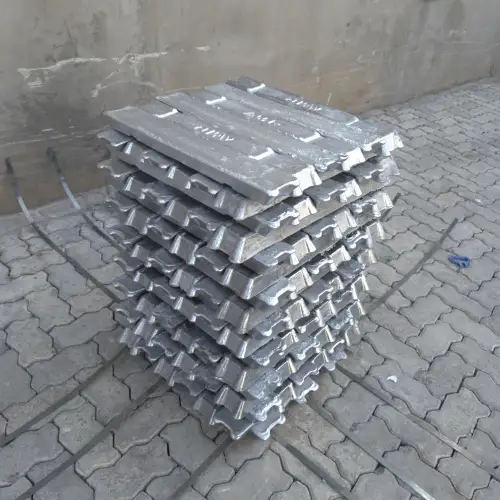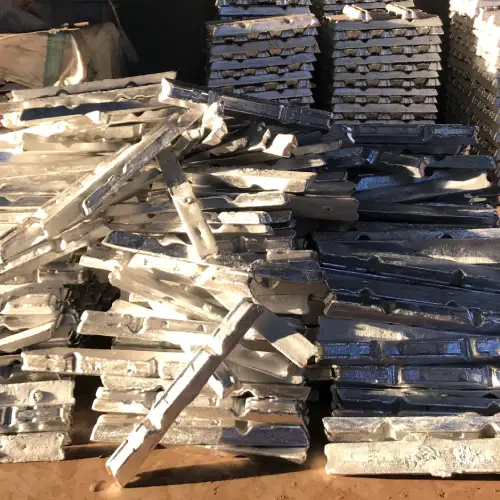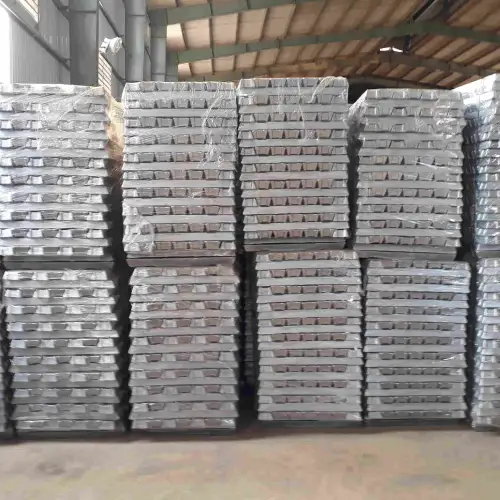OUR PRODUCTS
Aluminium Alloys
| Alloy | Weight |
|---|---|
| ADC12 | 5 kg |
| ADC12Z | |
| LM6 | |
| LM24 | |
| AK5M2 |
We Manufacture the Following Grades:
| Alloy | Cu | Si | Mg | Zn | Fe | Mn | Ni | Sn | Pb | Ti | Al |
|---|---|---|---|---|---|---|---|---|---|---|---|
| ADC12 | 1.5 to 3.5 | 9.6 to 12.0 | 0.3 max | 1.0 max | 1.3 max | 0.5 max | 0.5 max | 0.2 max | 0.20 max | 0.30 max | Balance |
| ADC12Z | 1.5 to 3.5 | 9.6 to 12.0 | 0.3 max | 3.0 max | 1.3 max | 0.5 max | 0.5 max | 0.2 max | 0.20 max | 0.30 max | Balance |
| LM6 | 0.1 max | 10.0 to 13.0 | 0.1 max | 0.1 max | 0.1 max | 0.5 max | 0.1 max | 0.05 max | 0.1 max | 0.20 max | Balance |
| LM24 | 3.0 to 4.0 | 7.5 to 9.5 | 0.30 max | 3.0 max | 1.30 max | 0.5 max | 0.4 max | 0.20 max | 0.3 max | 0.20 max | Balance |
| AK5M2 | 1.5 to 3.5 | 4 to 6 | 0.2 to 0.8 | 1.5 max | 1.30 max | 0.2-0.8 | 0.5 max | 0.05-0.2 | Balance |
Aluminum alloy (or aluminum compounds; see spelling contrasts) are composites in which aluminum (Al) is the overwhelming metal. Aluminum (Al) alloys are widely used in various industries due to their unique combination of properties, such as light weight, good thermal and electrical conductivity, corrosion resistance, and formability. When alloyed with other elements, the mechanical and physical properties of aluminum can be modified to fit specific applications. The typical alloying components are copper, magnesium, manganese, silicon, tin and zinc. About 85% of aluminum is used for wrought products, for example rolled plate, foils and extrusions. Cast aluminum alloys yield cost-effective products due to the low melting point, although they generally have lower tensile strengths than wrought alloys. The most significant cast aluminum composite framework is Al–Si, where the abnormal amounts of silicon (4.0 - 13%) add to give great throwing qualities. Aluminum compounds are broadly utilized in designing structures and segments where light weight or consumption obstruction is required.
TYPES
Classification of Aluminium Alloys
Aluminum alloys can be broadly categorized into two groups:
Principal Alloying Elements
- Copper (Cu): Aluminum alloys with Cu, like the 2000 series, are known for their strength. However, they have less corrosion resistance than other alloys.
- Manganese (Mn): Alloys like the 3000 series are primarily alloyed with manganese. They have moderate strength and good workability.
- Silicon (Si): Silicon is the primary alloying element in the 4000 series and is used in casting alloys. The combination of silicon and aluminum offers good casting properties.
- Tin (Sn): This is used in some casting alloys.
- Magnesium (Mg): Alloys in the 5000 series have magnesium as the primary alloying element. They exhibit good strength, weldability, and corrosion resistance.
- Zinc (Zn): The 7000 series alloys, with zinc as the primary alloying element, are high-strength materials. They're commonly used in aerospace applications.
- Magnesium and Silicon (Mg2Si): The 6000 series alloys contain both magnesium and silicon, which makes them heat treatable. They have moderate strength, good formability, weldability, and corrosion resistance.
Connect with us
to explore various options
on recycled aluminium
Aluminium Alloys Applications
Aluminum alloys have a wide range of applications due to their varying properties. Here's a detailed look at the applications of aluminum alloys:
- Aerospace and Aircraft: The lightweight nature and high strength-to-weight ratio of certain aluminum alloys, especially the 2000, 6000, and 7000 series, make them ideal for aircraft parts, space vehicles, and other aerospace components.
- Automotive: Aluminum alloys are used for various parts of vehicles including the chassis, panels, wheels, and engine components. They help in weight reduction, fuel efficiency, and emission reduction.
- Construction: Aluminum alloys, particularly the 5000 and 6000 series, are used in building and construction for window frames, roofing, siding, and architectural structures due to their durability and resistance to corrosion.
- Packaging: Because of their resistance to corrosion and lightweight nature, aluminum alloys are used extensively in the packaging industry for cans, foils, and wrappers.
- Marine: The 5000 series is popular in marine applications due to its excellent resistance to saltwater corrosion. It's used for shipbuilding, hulls, and other marine equipment.


- Railroad Cars and Transport: Aluminum alloys are used to reduce the weight of railway cars, enhancing fuel efficiency and load capacity.
- Electrical: Pure aluminum and its alloys are used in overhead lines, electrical conductors, and other electronic components due to their good electrical conductivity.
- Consumer Goods: Electronics casings, kitchen utensils, sporting goods like baseball bats and golf clubs, and many other consumer goods utilize aluminum alloys for their combination of lightness, strength, and aesthetics.
- Machinery and Equipment: Machines, tools, and equipment used in various industries incorporate aluminum alloy components due to their lightweight and durable nature.
- Heat Exchangers and Radiators: Aluminum's high thermal conductivity makes it an excellent choice for radiators, heat exchangers, and air conditioning systems.
- Cycling and Sporting Equipment: Aluminum alloys, particularly the 7000 series, are used to produce lightweight, durable bicycle frames, rock-climbing gear, and other sporting equipment.
- Defense and Firearms: Aluminum alloys are utilized in various defense applications ranging from vehicle armor to components of firearms.
- Fuel Tanks: Aluminum alloys are used for making fuel tanks, especially for aircraft, because of their lightweight nature and resistance to corrosion.
- Bridges and Infrastructure: In places where corrosion from environmental factors like saltwater is a concern, aluminum alloys are chosen for parts of bridges and infrastructure.
- Optics and Reflectors: Due to aluminum's ability to reflect light and radiation, it's used for making mirrors, telescope mirrors, and reflectors in lighting fixtures.



